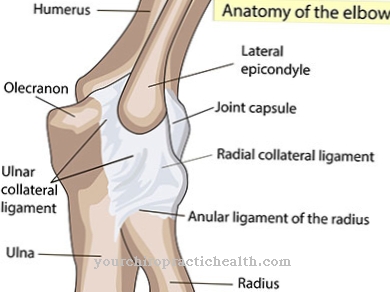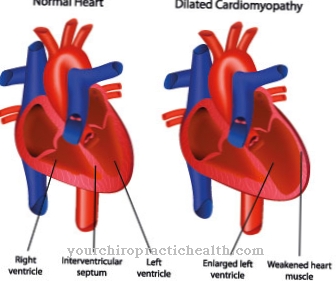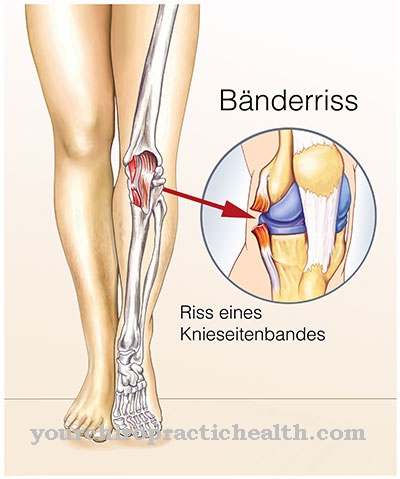Keratoconjunctivitis sicca is the summary term for dry eyes, regardless of possible causes. The term is also synonymous Dry eye syndrome used. The symptoms affect the cornea and conjunctiva, a mucous membrane-like tissue that connects the eyeball to the eyelids. If left untreated, dry eyes can lead to secondary damage.
What is keratoconjunctivitis sicca?

© joshya - stock.adobe.com
Keratoconjunctivitis sicca is the technical term for that dry eye syndromewithout considering the various causes for the occurrence of the syndrome. The term keratoconjunctivitis sicca already indicates that the cornea and conjunctiva are affected. The conjunctiva is formed by a mucous membrane-like tissue that connects the eyeball with the eyelids.
Proper, regular moistening of the cornea ensures - in the truest sense of the word - smooth movement of the eyeball, clear optics without streaks and distortions, and supply and disposal of the cornea. Except when the eyes are closed, the tear fluid supplies the cornea with oxygen and some nutrients and offers protection against bacterial inflammation.
In addition, the tear fluid ensures that the dead corneal cells or small foreign bodies are washed out. If left untreated, dry eyes lead to further problems and diseases. In principle, the syndrome can be caused by an insufficient production of tear fluid or a change in the composition of the tear fluid.
causes
There are many different causes that can lead to keratoconjunctivitis sicca and require different treatments to combat the cause. Temporary dry eyes can be caused by unusual environmental conditions such as the combination of strong winds with extremely dry air or air conditioning with integrated air drying, because the tear film dries out very quickly.
Certain diseases can reduce the production of serous tear fluid and thus trigger the symptoms of dry eyes. The production of tear fluid depends, among other things, on the hormone and vitamin balance. A lack of testosterone in older men or a lack of vitamin A can contribute to dryness of the eyes.
The most common cause, however, is a qualitative change in the tear fluid. An impairment of the accessory meibomian glands in the eyelids is often observed, which normally release a fatty substance that covers the tear film in the form of a thin outer lipid layer and protects it from rapid dehydration. A pathologically reduced production of the meibomian glands leads to very rapid evaporation of the tear film due to the lack of a lipid layer.
Direct diseases and inflammation of the lacrimal glands or the obstruction of the outlets and the accessory glands can also result in insufficient production or a changed composition of the tear fluid.
Symptoms, ailments & signs
The most common symptoms and complaints caused by keratoconjunctivitis sicca are dryness, burning of the eyes and often the feeling that there are foreign objects on the cornea - a feeling similar to conjunctivitis. The external signs are reddened and tired eyes, and there is usually an over-sensitivity to bright light and drafts.
In some cases watery eyes occur, which may sound absurd at first. The inner layer of the tear film, which is only 18 micrometers thick, consists of a thin layer of mucus that ensures that the tear film adheres to the eyeball. If the function of the accessory tear glands, which secrete the mucous film, is disturbed, the tear film cannot adhere sufficiently to the eyeball. The tear fluid runs out of the eye and the symptoms of watery eyes appear, even though the cornea is dry.
Diagnosis & course of disease
The first step in diagnosing keratoconjunctivitis sicca is the anamnesis and the initial discussion with the patient. If an initial suspicion arises, the ophthalmologist can examine the amount and composition of the tear fluid after inspecting the surface of the eye using a slit lamp. With the so-called Schirmer test, the tear fluid produced within 5 minutes can be absorbed and determined with a special paper strip.
The composition of the tear film is measured indirectly using the tear open time. This is the time between blinking an eye and tearing the tear film. Further examinations can concern hormone status, rheumatoid factors and other parameters. As long as there is no serious damage to the cornea and conjunctiva, the dry eye syndrome regresses as soon as the cause is removed. If left untreated, keratoconjunctivitis sicca can lead to serious corneal damage and disease.
Complications
Due to keratoconjunctivitis sicca, those affected mainly suffer from very dry eyes. This can have a negative impact on the quality of life of the person concerned. If there is no treatment and the symptoms persist, irreversible consequential damage is possible. In most cases there is also a burning sensation in the eyes.
The patient's eyes are reddened and tired. Furthermore, keratoconjunctivitis sicca can also lead to conjunctivitis, which must definitely be treated by a doctor. There is also a strong sensitivity to light. The everyday life of the person concerned is made more difficult by these complaints and normal work or activities can no longer be carried out easily.
The treatment of keratoconjunctivitis sicca is usually causal and depends on the underlying disease. There are no particular complications and the disease usually progresses positively. Life expectancy is also not reduced or restricted by keratoconjunctivitis sicca. With the help of eye drops or other therapies, the symptoms of this disease can be relieved.
When should you go to the doctor?
If the person concerned suffers from a persistent feeling of dryness in the eye area, a visit to a doctor is advisable. Burning and itchy eyes indicate existing irregularities that should be examined by a doctor. If you feel a foreign body in your eyes or if your usual vision is disturbed, a doctor should be consulted. Check-ups are necessary to clarify the cause.
If you feel hypersensitive to normal light influences or in broad daylight, you should consult a doctor. The sensitivity of the eyes indicates a disorder that should be investigated and treated. Reddened, easily tired or watery eyes should also be examined by a doctor. If the existing complaints lead to itching or open wounds, the person concerned needs sterile wound care. Otherwise pathogens can penetrate the organism and contribute to the development of further diseases.
In the event of headaches, inner restlessness, reduced well-being or restrictions in performing everyday tasks, it is advisable to consult a doctor. If, in addition to the physical complaints, abnormal behavior, mood swings or a depressed appearance occur, a doctor should be asked for help. Due to the impairment, there is an increased vulnerability to developing a mental illness.
Therapy & Treatment
In addition to combating symptoms, the aim of treating dry eyes is primarily to eliminate the cause. If the production of tear fluid is too low, various eye drops can be used as a tear substitute to alleviate the symptoms. If it is a hyperevaporative form of dryness, i.e. the problem of an excessive evaporation rate, eye drops containing lipids can help.
However, at the same time an attempt should be made to reactivate the function of the meibomian glands so that the protection of the tear film is restored by a natural lipid layer. There are also more extensive treatment options aimed at eliminating the causal factors.
You can find your medication here
➔ Medicines for eye infectionsOutlook & forecast
A prognosis for keratoconjunctivitis sicca is only possible once the cause of the symptoms has been determined. The dryness of the eyes can be developed for various reasons. Drug treatments are often used for inflammation. These normally lead to an alleviation of the existing symptoms within a few days or weeks. Most of the time, the administration of the medication documents the freedom from symptoms after a short time. Consequential disorders are not to be expected in these patients. In the course of life, however, a renewed inflammation can occur at any time with an equally favorable prognosis.
If there is a chronic underlying disease, the probability of a cure worsens. Some patients experience lifelong complaints. You will receive long-term therapy in which the dryness of the eye is treated. Regular check-ups are necessary so that we can react as quickly as possible in the event of abnormalities or unfortunate changes.
If the function of the meibomian glands is permanently damaged, the affected person is also given an unfavorable prognosis. Again, ongoing therapy is used so that symptoms can be regulated. Some patients have no prospect of a cure. Nevertheless, the treatment method can significantly improve the symptoms. If prescribed medication is discontinued, an immediate relapse of the irregularities can be expected in this case.
prevention
Direct prevention to avoid keratoconjunctivitis sicca is hardly possible due to the multitude of possible causes. However, living conditions that favor dry eye syndrome can be avoided. Above all, it is advisable to react to the first signs such as burning eyes and a feeling of foreign objects in the eye in order to alleviate the symptoms immediately. If symptoms persist, an ophthalmologist should be consulted immediately, as it cannot be ruled out that the dry eyes may hide serious illnesses.
Aftercare
In most cases, follow-up care options for keratoconjunctivitis sicca are very limited. Here, those affected are primarily dependent on an early diagnosis of the disease so that further complications and complaints can be prevented. The earlier a doctor is contacted, the better the further course is usually.
As a rule, self-healing cannot occur in keratoconjunctivitis sicca. Most patients are dependent on various medications for this condition. In any case, the patient should ensure that they are taken regularly and that the dosage is correct in order to permanently alleviate the symptoms.
If anything is unclear or if you have any questions, you should always consult a doctor first so that no further complications can arise. In everyday life, the help and support of one's own family has a positive effect on the course of keratoconjunctivitis sicca and can also prevent or alleviate depression or other psychological disorders. In some cases, the disease leads to a reduced life expectancy for those affected.
You can do that yourself
In order to support the quality of life and the success of the treatment of keratoconjunctivitis sicca, the patients work closely with the treating doctor and follow the instructions for taking medication and other treatment approaches. In therapy, it is essential to identify the underlying causes of the disease and to eliminate or reduce them. As a result, the symptoms usually subside and the quality of life of those affected increases.
The patients take the prescribed preparations as prescribed by a doctor, which replace the tear fluid and relieve the dryness of the eye. In addition, the patients try to find those factors in their everyday life that contribute to the existence of keratoconjunctivitis sicca. Depending on the activities and occupation, these are different reasons in individual cases, the identification and reduction of which, however, often represents an essential step in the genesis.
Patients reduce the time they spend in front of screens such as computers or televisions. The symptoms of dry eyes are often reduced even with higher air humidity. However, some patients also suffer from certain allergies that promote dry eyes and which need to be diagnosed.


.jpg)









.jpg)



.jpg)










.jpg)
